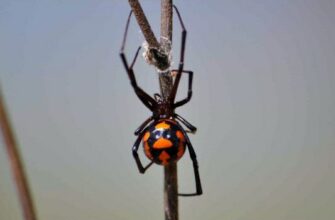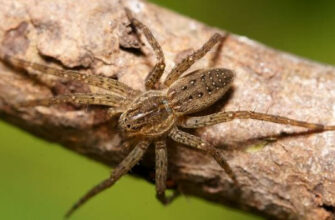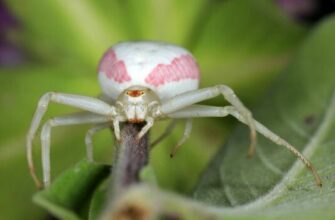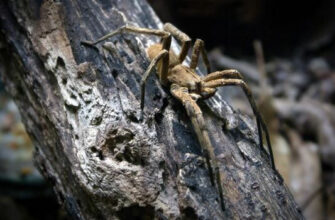The cross spider is a huge group of arachnids, which has about six hundred species, about one and a half to two dozen of which are found on the territory of Russia. Representatives of this species are ubiquitous, found in almost every country. Their favorite habitat is places with a high moisture content. Very often they penetrate into a person’s dwelling.
These spiders are called crosses because of the peculiar coloring in the back area. It is in this part of the body that spiders have a peculiar pattern in the form of a cross, which is characteristic only for this type of arthropod. With the help of this feature, they scare away birds and other representatives of flora and fauna that do not mind eating spiders.
Origin of the species and description
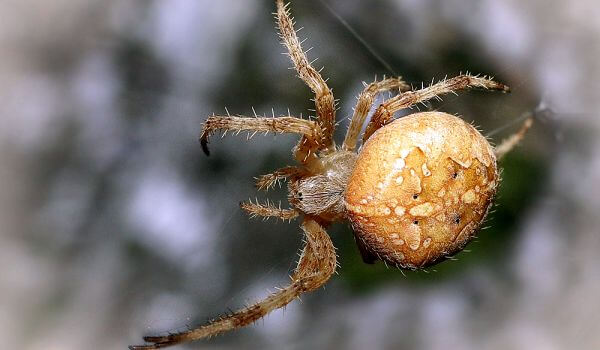
Photo: Cross Spider
Spiders are representatives of the order of spiders , suborder of araneomorphic spiders, family Araneidae, genus of crosses.
To date, scientists can only roughly indicate the period of the appearance of ancient arthropods. The chitinous shell of these representatives of flora and fauna disintegrates rather quickly, leaving practically no traces. A few remains of ancient arthropods were found in pieces of hardened resin, or in amber. Today, zoologists call the approximate period of the appearance of arachnids – 200-230 million years ago. The first spiders had very small body sizes that did not exceed half a centimeter.
Video: Cross Spider
Their body structure also differed significantly from the modern one. The spiders of that time had a tail, which was intended for the manufacture of strong web threads. The so-called cobwebs were used to line their burrows, or shelters, and to protect their eggs from damage and extinction. In the process of evolution, the tail part of the ancient arthropods disappeared. However, the modern spinning machine that they now have did not appear immediately.
The first spiders appeared presumably in Gondwana. Then they very rapidly spread throughout almost the entire territory of the land. Subsequent ice ages significantly narrowed the regions of their residence. Arthropods are characterized by a fairly rapid evolution, during which spiders changed outwardly depending on the region of habitat, as well as on belonging to a particular species.
Appearance and Features
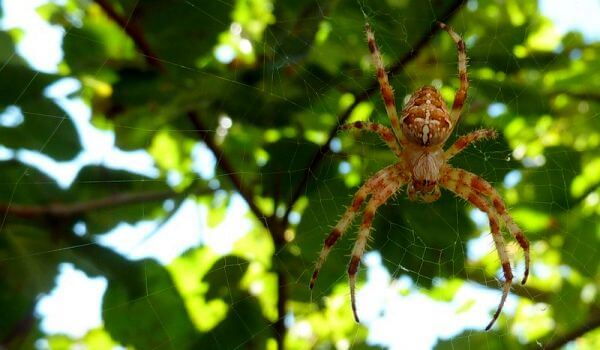
Photo: Big cross spider
Like other representatives of arachnids, the body of the cross is divided into two segments: the cephalothorax and abdomen. In addition, they have arachnoid warts and the walking apparatus, the latter is represented by the thigh, knee joint, lower leg, forepaws, tarsi and claw. Spiders also have chelicerae and pedipalps.
Spiders have fairly small body sizes. Representatives of this species have pronounced sexual dimorphism – males are significantly inferior to females in body size. The average body length of a female is 2.0-4.5 cm, and that of a male is 1.0-1.2 cm.
The body of the arthropod is covered with a sand-colored chitinous shell, which insects tend to shed during the molting period.
Spiders have 12 limbs:
- one pair of chelicerae, the main purpose of which is fixation and killing caught prey. This pair of legs point downward;
- four pairs of walking limbs that have claws at the tips;
- one pair of pedipalps, which are designed to fix their prey. It is noteworthy that on the last segment of these limbs in males there is a reservoir into which seminal fluid enters, which is subsequently transferred to the female’s seminal receptacle.
The crosses have as many as four pairs of eyes, but they are weakly developed. The vision of these representatives of arthropods is poorly developed, they can only distinguish silhouettes and general outlines. Touch serves as a reference point in the surrounding space. This function is performed by hairs that cover almost the entire body.
Interesting fact: On the body of spiders there are a huge variety of hairs of various types. Each species is responsible for receiving certain types of information: light, sound, movement, etc.
The belly of the cross has a round shape. It does not have any segments. On the upper surface there is a clearly defined pattern in the form of a cross. In its lower part there are three pairs of special arachnoid warts. It is in these warts that thousands of glands open, which produce strong, reliable spider webs.
The respiratory system is located in the abdomen and is represented by two lung sacs and a tracheal tube. The heart is located in the back. It has the shape of a tube with vessels branching off from it.
Where does the cross spider live?
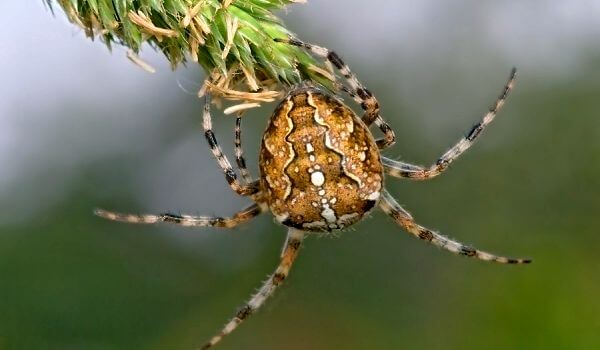
Photo: Spider cross in Russia
Spiders of this species are characterized by ubiquitous distribution. They live in almost every country in Eurasia. Also quite common in North America.
Crosses prefer areas with high humidity, little sunlight and high air temperatures. Spiders are very fond of merging on the edges of forests, meadows, gardens, and fields. The human dwelling is no exception. Getting into living quarters, spiders climb into crevices or joints between walls, inaccessible places, spaces between furniture and a wall, etc. Often crosses can be found on various types of vegetation located near a reservoir.
Geographical regions of habitat:
- the territory of almost all of Europe;
- Russia;
- Africa;
- Asian countries;
- North America.
Spiders prefer to settle where it is easy and convenient to weave their trapping nets, into which a sufficient number of insects are likely to fall. On the territory of Russia, crosses are often found in city parks and squares.
Now you know where the cross spider lives. Let’s see what it eats.
What does the spider spider eat?
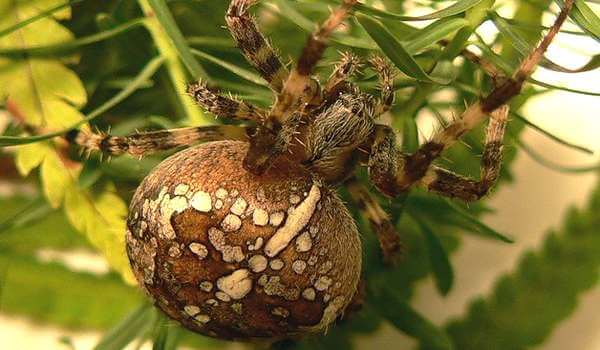
Photo: Spider spider in nature
The spider is far from a harmless representative of arthropods. It belongs to the poisonous species of arachnids, and is considered a hunter by nature. Most often he goes hunting at night.
What is the source of food:
- flies;
- mosquitoes;
- butterflies;
- gnats;
- aphids.
Getting out to hunt, the cross is located in the central part of the web and freezes. If you watch him during this period of time, it seems that he is dead. However, if the prey gets into the net, the spider immediately plunges the front pair of limbs into it, injecting poison. After a short period of time, the potential food stops resisting. Crosses can eat it right away, or leave it for later.
These representatives of arachnids are considered voracious. To get enough, they need an amount of food per day that exceeds their own body weight. For this reason, spiders spend most of the day hunting. They rest mainly during the day. Even during the rest period, the signal thread is always tied to one of the limbs of the cross.
Interesting fact: The spider does not eat everyone who falls into its trapping nets. If a poisonous insect gets into them, or one that exudes an unpleasant odor, or a huge insect, the spider simply bites the fixing threads and releases it.
Arthropods have an external type of digestive tract. They cannot digest food on their own. They tend to partially digest it with the help of injected poison. Only after the insides of the caught insect turn into a liquid substance under the action of the toxin, the spiders drink it. Also, spiders often, after paralyzing the victim, wrap it in a cocoon of their web. It also undergoes a process of partial digestion.
Character and Lifestyle Features
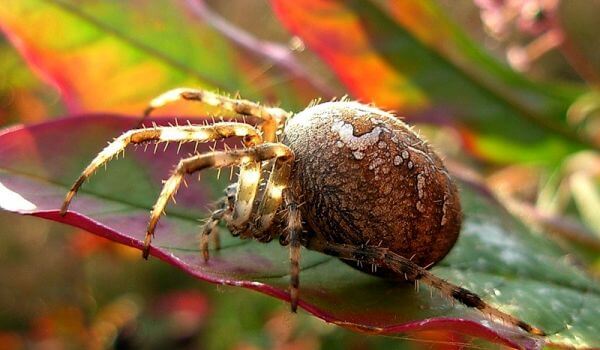
Photo: Common spider
Spiders are nocturnal arthropods that tend to be most active at night. Most of their time is spent hunting, they have little rest. As habitats, be sure to choose places where there is a large amount of moisture and little sunlight.
Webs are often weaved between the branches of shrubs, trees, various types of vegetation, blades of grass, etc. Themselves are located in a secluded place near their hunting net. Spider threads that are capable of weaving crosses have great strength and are able to hold even fairly large insects, whose dimensions are several times greater than the size of the body of the spider itself.
Crosses are considered real hard workers, as they tirelessly weave their web. They tend to weave huge webs. After they become unsuitable for catching prey, they scatter it and weave new webs.
Interesting fact: A spider will never get entangled in its own trapping webs, as it always moves strictly along certain trajectory of non-sticky areas.
Spiders weave webs also mainly at night. This is due to the fact that the main enemies of the crosses are diurnal and hunt them during daylight hours. Spiders in the process of forming a trapping network show accuracy, detail and scrupulousness. In the process of their life, they rely not on sight, but on touch. Crosses lead an exclusively solitary lifestyle.
Social Structure and Reproduction
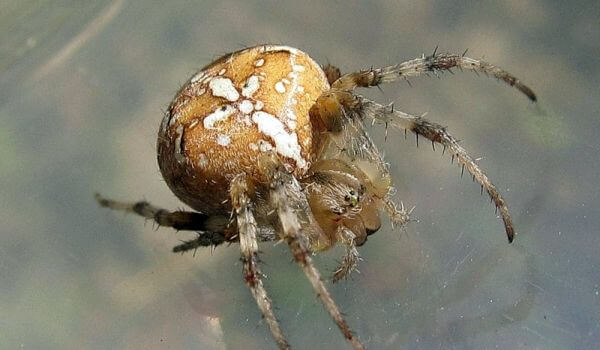
Photo: Cross Spider
Throughout spring and summer, males are busy forming webs and providing enough food. During the onset of the mating season, males leave their shelters and begin to actively search for a female for mating. During this period, they practically do not eat anything, which explains such a significant difference between males and females.
Crosses are dioecious arthropods. The period of marriage and courtship of females often occurs at night. It consists in the performance by males of peculiar dances, which consist in tapping with limbs. After the male manages to reach the head of the female with his limbs, the transfer of seminal fluid occurs. After mating, most males die from the poisonous secret of the female.
The period of marital relations falls on the end of the summer season, the beginning of autumn. The female makes a cocoon from the web, in which she places the eggs. One cocoon can contain from 3 to 7 hundred honey-colored eggs. At first, the female wears this cocoon on herself, then she finds a secluded place and hides it. The cocoon reliably hides future offspring from rain, wind and cold. In the spring, spiderlings begin to emerge from the eggs. For a short period of time they are inside the cocoon, then they come out of it and spread in different directions. Small crosses immediately become independent and lead an isolated lifestyle.
After the spiderlings leave the cocoon, they try to separate as quickly as possible. In view of the high competition and the possibility of becoming food for older individuals, such a move will significantly increase the chance of survival.
Interesting fact: Due to the fact that newly born young individuals have rather small and weak limbs, in order to separate from each other, they use a web on which they can fly up to several hundred kilometers, provided there is wind.
Spiders adapt well to new conditions. It is because of this that lovers of exotic representatives of flora and fauna often give them as pets. For their maintenance, a terrarium of sufficient quantity is used to provide space for a fairly large web.
Natural enemies of cross spiders
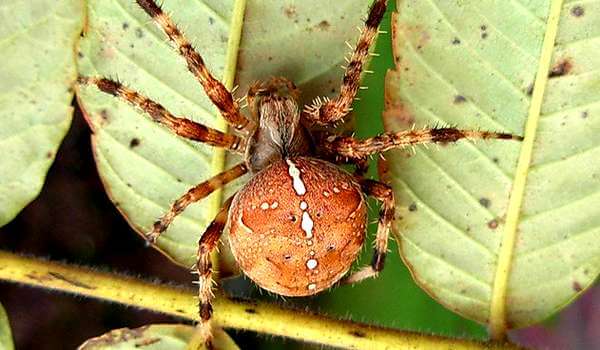
Photo: Female cross spider
Despite the fact that the crusader is ranked among the dangerous, poisonous spiders, he also has enemies. It is to reduce the likelihood of being eaten that they are most active at night. The main enemies of this species of arthropods can be called birds, as well as insects – parasites. Some species of wasps and flies wait for the spider to freeze on its web in anticipation of the next victim, fly up to it and instantly lay eggs on its body.
Subsequently, parasite larvae appear from them, which, in fact, feed on the insides of the spider. When the number of parasites increases, they practically eat the spider alive. Crusaders are small in size, which often results in them becoming the prey of other, larger arachnids themselves. Some amphibians, such as lizards or toads, can also be attributed to the enemies of the crusaders.
The main enemies of the cross spider in natural conditions:
- salamanders;
- geckos;
- iguanas;
- frogs;
- hedgehogs;
- bats;
- ants.
Man is not the enemy of the spider. Rather, crusaders in some cases can cause harm to human health. They don’t tend to attack first. When meeting with a person, these representatives of arthropods rush to hide. However, if they sense danger, they attack. As a result of a bite, an adult healthy person will not die, however, he will definitely feel discomfort and a change in general well-being.
The consequence of the bite of the cross is pain, dizziness, nausea, vomiting, swelling, suppuration of the bite site. Most often, all of the above symptoms disappear without medical treatment.
Population and species status
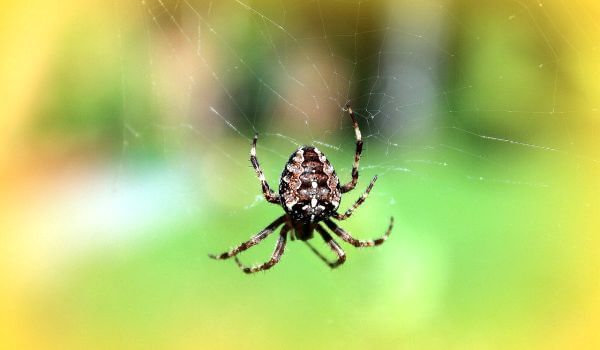
Photo: Cross Spider
Today, the cross spider is considered a very common representative of arachnids. It inhabits most of the territory of Eurasia and North America.
The cross combines a large number of subspecies of spiders. Some of them are distributed over a vast territory, others have a very limited habitat. For example, the Hawaiian wolf spider lives exclusively on the territory of the island of Kautai.
The spider, which scientists call the striped hunter, is widespread throughout almost the entire territory of Europe. There are no special programs and activities aimed at preserving and increasing the number of arthropods.
In many countries in different parts of the world, people breed crusaders as an exotic animal in a terrarium. The crusader spider is an integral part of the ecosystem. Many people mistakenly believe that if an insect or arthropod is poisonous, it must be destroyed. It’s a delusion. A person must understand that if such an important link as spiders disappears, irreparable damage will be done to the biosphere of the earth.

